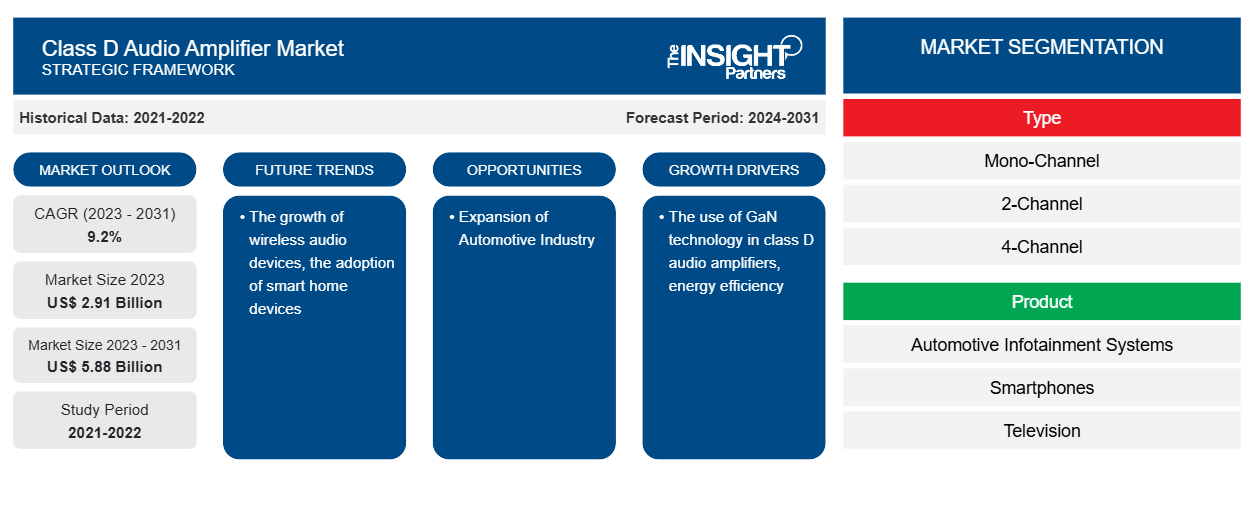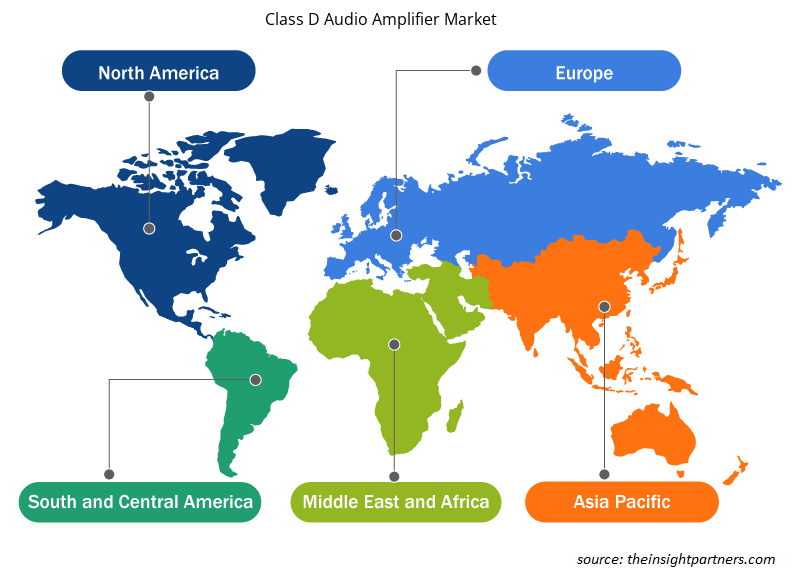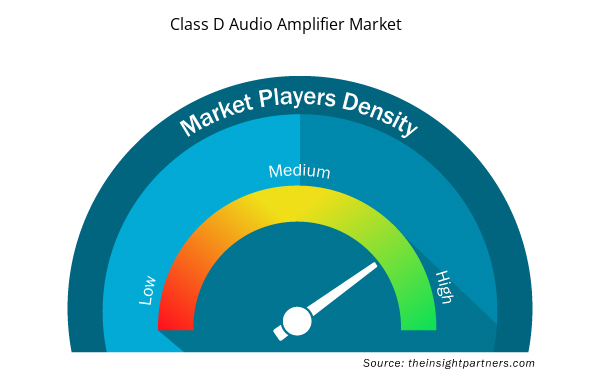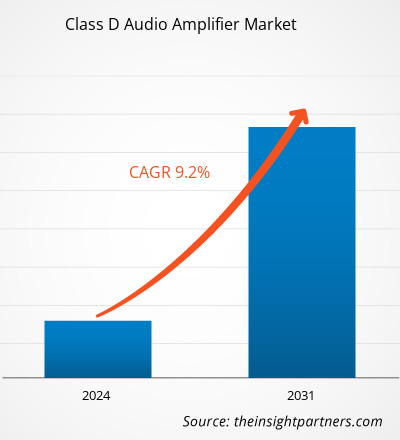The class D audio amplifier market size is projected to reach US$ 5.88 billion by 2031 from US$ 2.91 billion in 2023. The market is expected to register a CAGR of 9.2% during 2023–2031. The growth of wireless audio devices and the adoption of smart home devices are likely to remain a key trend in the market.
Class D Audio Amplifier Market Analysis
In essence, a Class D audio amplifier is a switching amplifier, sometimes known as a PWM amplifier. Large-scale public address, voice reinforcement, and live sound systems are increasingly using Class D technology in place of the historically cumbersome, heavy, and inefficient power amplifiers. Class-D amplifiers can also be a good fit for Bluetooth headphones, while other amplifier types can also be used in this specific scenario due to the relatively low volume needs. Class D amplifiers are also found in a wide range of other goods, such as stereo amplifiers and portable headphone amplifiers.
Class D Audio Amplifier Market Overview
The major factors driving the demand for class D audio amplifiers are the rising use in consumer electronic devices such as speakers, Bluetooth audio devices, and home theatres, among others. Rising car infotainment system demand is also driving the market demand globally.
Customize This Report To Suit Your Requirement
You will get customization on any report - free of charge - including parts of this report, or country-level analysis, Excel Data pack, as well as avail great offers and discounts for start-ups & universities
Class D Audio Amplifier Market: Strategic Insights

- Get Top Key Market Trends of this report.This FREE sample will include data analysis, ranging from market trends to estimates and forecasts.
You will get customization on any report - free of charge - including parts of this report, or country-level analysis, Excel Data pack, as well as avail great offers and discounts for start-ups & universities
Class D Audio Amplifier Market: Strategic Insights

- Get Top Key Market Trends of this report.This FREE sample will include data analysis, ranging from market trends to estimates and forecasts.
Class D Audio Amplifier Market Drivers and Opportunities
Use of GaN Technology in Class D Audio Amplifiers to Favor the Market
Silicon MOSFET has been used as the de facto transistor device technology in the creation of Class-D amplifiers. GaN technology now makes it feasible to design a new generation of amplifiers that will lead to significant advancements in product performance and audio quality. Silicon MOSFETs' fast switching limits the audio performance options available to designers. GaN transistors have a substantially higher operating frequency, enabling smooth, quick switching transitions. As a result, GaN Class-D audio systems include smaller, more effective audio devices with noticeably better audio performance. The application of GaN technology in Class-D audio design will make it possible for designers to produce a new wave of inventive products with enhanced energy economy and better audio performance in new, smaller form factors at cost-effective pricing.
Expansion of Automotive Industry
The global automotive industry is on the rise. With a rising preference for state-of-the-art in-car entertainment centers, the demand for class D audio amplifiers is on the rise. With the integration of entertainment, navigation, communication, and vehicle control systems into seamless user experiences, automotive and infotainment constitute a critical confluence of technology within contemporary automobiles. Through a variety of onboard electronics and apps, automotive infotainment, also known as in-vehicle infotainment (IVI), provides drivers and passengers with entertainment and information. It is an integration of hardware and software. Class D audio amplifiers form a major part of the audio systems in the car. Thus, the rising preference for enhanced infotainment systems is creating opportunities for the growth of the Class D audio amplifier market.
Class D Audio Amplifier Market Report Segmentation Analysis
Key segments that contributed to the derivation of the class D audio amplifier market analysis are type, product, and industry vertical.
- Based on the type, the class D audio amplifier market is divided into mono-channel, 2-channel, 4-channel, and 6-channel. The mono-channel segment held the largest share in 2023.
- Based on the product, the market is divided into automotive infotainment systems, smartphones, television, and others.
- Based on the industry vertical, the market is divided into automotive, consumer electronics, and others.
Class D Audio Amplifier Market Share Analysis by Geography
The geographic scope of the class D audio amplifier market report is mainly divided into five regions: North America, Asia Pacific, Europe, Middle East & Africa, and South & Central America.
North America holds a significant share of the class D audio amplifier market in 2023. North America is one of the largest consumer electronic markets and also a major automobile manufacturer. Countries such as the US are home to major consumer electronic manufacturers in the world thus driving the growth of the region.
Class D Audio Amplifier Market Regional Insights
The regional trends and factors influencing the Class D Audio Amplifier Market throughout the forecast period have been thoroughly explained by the analysts at Insight Partners. This section also discusses Class D Audio Amplifier Market segments and geography across North America, Europe, Asia Pacific, Middle East and Africa, and South and Central America.

- Get the Regional Specific Data for Class D Audio Amplifier Market
Class D Audio Amplifier Market Report Scope
| Report Attribute | Details |
|---|---|
| Market size in 2023 | US$ 2.91 Billion |
| Market Size by 2031 | US$ 5.88 Billion |
| Global CAGR (2023 - 2031) | 9.2% |
| Historical Data | 2021-2022 |
| Forecast period | 2024-2031 |
| Segments Covered |
By Type
|
| Regions and Countries Covered | North America
|
| Market leaders and key company profiles |
Class D Audio Amplifier Market Players Density: Understanding Its Impact on Business Dynamics
The Class D Audio Amplifier Market is growing rapidly, driven by increasing end-user demand due to factors such as evolving consumer preferences, technological advancements, and greater awareness of the product's benefits. As demand rises, businesses are expanding their offerings, innovating to meet consumer needs, and capitalizing on emerging trends, which further fuels market growth.
Market players density refers to the distribution of firms or companies operating within a particular market or industry. It indicates how many competitors (market players) are present in a given market space relative to its size or total market value.
Major Companies operating in the Class D Audio Amplifier Market are:
- Analog Devices, Inc
- INFINEON TECHNOLOGIES AG
- NXP Semiconductors.
- ON Semiconductor Corporation
- Qualcomm Technologies, Inc.
- STMicroelectronics N.V.
Disclaimer: The companies listed above are not ranked in any particular order.

- Get the Class D Audio Amplifier Market top key players overview
Class D Audio Amplifier Market News and Recent Developments
The class D audio amplifier market is evaluated by gathering qualitative and quantitative data post primary and secondary research, which includes important corporate publications, association data, and databases. A few of the developments in the class D audio amplifier market are listed below:
- Infineon Technologies AG recently introduced its latest generation of MERUS™ multilevel Class D audio amplifiers. Several ecosystem partners of Infineon are now ready to support interested customers with their design-in efforts. Partnering with the experts, the company aims to boost the adoption of new and innovative technology. Infineon’s Class D audio amplifiers enable high-fidelity sound playback with a unique Class D modulation of up to 5 different output voltage levels. (Source: Infineon Technologies, Press Release, January 2023)
Class D Audio Amplifier Market Report Coverage and Deliverables
The “Class D Audio Amplifier Market Size and Forecast (2021–2031)” report provides a detailed analysis of the market covering below areas:
- Class D audio amplifier market size and forecast at global, regional, and country levels for all the key market segments covered under the scope
- Class D audio amplifier market trends, as well as market dynamics such as drivers, restraints, and key opportunities
- Detailed PEST/Porter’s Five Forces and SWOT analysis
- Class D audio amplifier market analysis covering key market trends, global and regional framework, major players, regulations, and recent market developments
- Industry landscape and competition analysis covering market concentration, heat map analysis, prominent players, and recent developments for the class D audio amplifier market
- Detailed company profiles
- Historical Analysis (2 Years), Base Year, Forecast (7 Years) with CAGR
- PEST and SWOT Analysis
- Market Size Value / Volume - Global, Regional, Country
- Industry and Competitive Landscape
- Excel Dataset


- Personality Assessment Solution Market
- Biopharmaceutical Contract Manufacturing Market
- Third Party Logistics Market
- Travel Vaccines Market
- Skin Tightening Market
- Sodium Bicarbonate Market
- Electronic Shelf Label Market
- Single-Use Negative Pressure Wound Therapy Devices Market
- Underwater Connector Market
- Cell Line Development Market

Report Coverage
Revenue forecast, Company Analysis, Industry landscape, Growth factors, and Trends

Segment Covered
Type , Product , and Industry Vertical

Regional Scope
North America, Europe, Asia Pacific, Middle East & Africa, South & Central America

Country Scope
Argentina, Australia, Brazil, Canada, China, France, Germany, India, Italy, Japan, Mexico, Russian Federation, Saudi Arabia, South Africa, South Korea, United Arab Emirates, United Kingdom, United States
Frequently Asked Questions
What is the expected CAGR of the class D audio amplifier market?
The class D audio amplifier market is expected to register a CAGR of 9.2% during 2023–2031
What would be the estimated value of the class D audio amplifier market by 2031?
The class D audio amplifier market size is projected to reach US$ 5.88 billion by 2031
What are the future trends of the class D audio amplifier market?
The growth of wireless audio devices and the adoption of smart home devices are likely to remain key trends in the market.
Which are the leading players operating in the class D audio amplifier market?
Analog Devices, Inc., INFINEON TECHNOLOGIES AG, NXP Semiconductors., ON Semiconductor Corporation, Qualcomm Technologies, Inc., STMicroelectronics N.V., Silicon Laboratories, Inc., Texas Instruments Incorporated, Maxim Integrated, and ICEpower a/s are among the leading payers operating in the class D audio amplifier market.
What are the driving factors impacting the class D audio amplifier market?
The use of GaN technology in class D audio amplifiers and energy efficiency are expected to drive the class D audio amplifier market.
Which region dominated the class D audio amplifier market in 2023?
North America dominated the class D audio amplifier market in 2023.

 Get Free Sample For
Get Free Sample For